SMC have worked a large number of various bridges internationally using prestressed concrete technologies.
We also develop innovative bridge structures that contribute to the sustainable society.
PC girder bridge
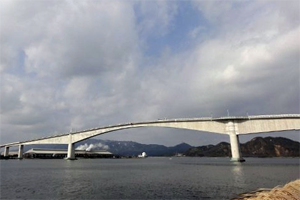
The most common type of prestressed concrete bridge. The structure withstands bending moment by introducing prestress into the concrete using prestressing steel. PC girder bridges include floor slab bridges, T-girder bridges, box girder bridges, as well as corrugated steel web box girder bridges, which are composite structures with lower web weight.
PC cable stayed bridge
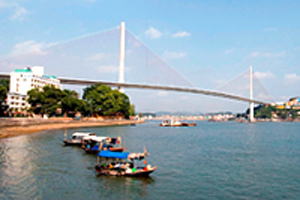
A bridge type where the main girders of the prestressed concrete structure are raised by cables stretching diagonally on both sides of the tower. Since the main girders are lifted by the diagonal cables, this structure is suitable for bridges with long spans, which are difficult to achieve with PC girder bridges.
Extradosed bridge
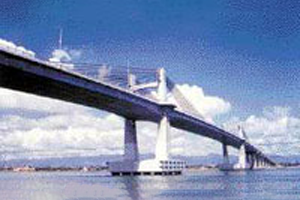
A type of prestressed concrete bridge structure with cables attached to the main girders from towers that are shorter than PC cable-stayed bridge towers. It combines the features of a PC cable-stayed bridge and a PC girder bridge. Because the cables are more horizontally inclined than cable-stayed bridges, they have greater resistance to fatigue caused primarily by variable traffic loads, and greater tension can be applied, which makes it possible to reduce the amount of materials used.
Butterfly web bridge
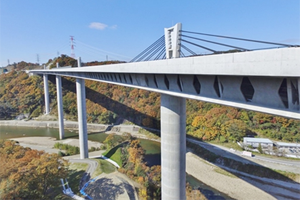
A prestressed concrete bridge where the webs of the concrete box girder bridge are replaced with thin butterfly-shaped panels. The thin panels used for the web are made of either high-strength fiber reinforced concrete or steel, selecting a design to suit ground and environmental conditions. This can reduce web weight by about 20% compared to concrete webs as well as improve quality by enabling main girder components to be precast in the factory.
Curved chord form PC bridge
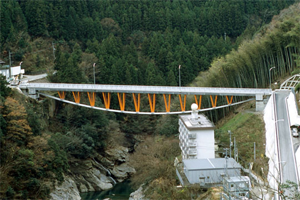
A bridge type that includes the upper deck suspension bridge, upper deck suspension truss bridge (curved chord truss bridge), bowstring girder bridge, and bowstring truss bridge (composite truss bridge). These are prestressed concrete bridges that have girders supported from underneath by curved tensile members.
Precast segment bridge
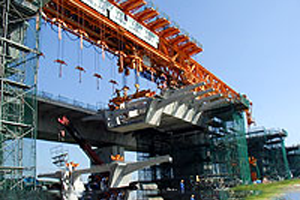
A prestressed concrete bridge with main girders segmented into shapes that are fabricated as precast segments, assembled onsite, and structurally integrated by prestressing PC steel strands. The precast segments are all fabricated at well-equipped production yards and factories, ensuring segment quality. Moreover, the construction period can be significantly shortened since the segments can be fabricated during substructure construction.
Ultra-hight durable bridge (Dura-Bridge)
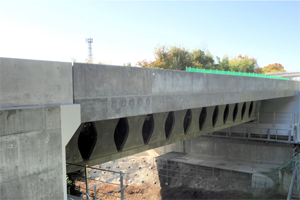
An ultra-long-lasting prestressed concrete bridge that uses new non-corrosive materials instead of corrodible steel reinforcing bars and PC strands. Our development of this maintenance-free bridge structure has made it possible to reduce bridge maintenance and management costs. Dura-Bridge was developed with the aim of providing sustainable social infrastructure.
Ultra-hight durable slab (Dura-Slab)
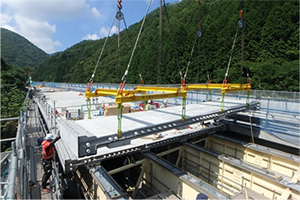
For deck slabs that are prone to deteriorate because of factors such as higher traffic volumes and gross vehicle weights, use of antifreeze agents, and salt damage in coastal areas in addition to aging, this highly durable precast deck slab uses new non-corrosive materials instead of reinforcing bars and PC strands. Dura-Slab enables the construction of maintenance-free bridge structures and provides sustainable social infrastructure.
Ultra-hight durable barrier (Dura-Barrier)
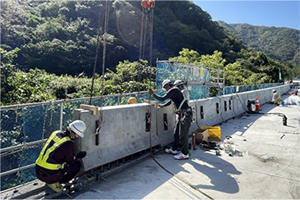
This highly durable precast bridge parapet eliminates all steel parts, such as reinforcing bars which are prone to corrosion, and uses non-corrosive GFRP rods as reinforcement for the parapet and as joints connecting to the deck slab. Installation work is extremely simple, making rapid construction possible. Dura-Barrier enables the construction of maintenance-free bridge structures and provides sustainable social infrastructure.
U-shaped girder lifting erection method
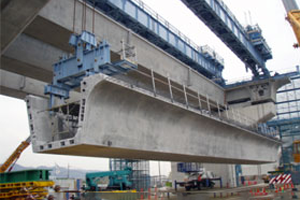
A construction method in which U-shaped precast concrete girders are positioned close to the bridge piers and erected span-by-span using lifting girders. This method is ideal for constructing large-scale, multi-span viaducts with relatively uniform spans and girder depths. Moreover, the quality can be further improved and the construction period shortened with the use of composite deck slabs made of PC panels.
Span-by-span erection with rear assembly system
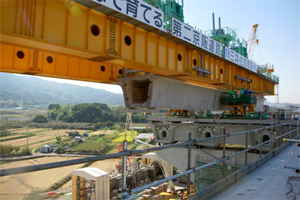
A construction method in which main girder segments are arranged, prestressed, and integrated on top of existing girders at the rear span to be erected, and then moved to the span position, lowered, and moved laterally using erection girders. This method is ideal for constructing large-scale, multi-span viaducts with relatively uniform spans and girder depths. Moreover, the quality can be further improved and the construction period shortened with the use of composite deck slabs made of PC panels.
The SPER method : Sumitomo Mitsui's Precast Form for Earthquake Resistance and Rapid Construction method
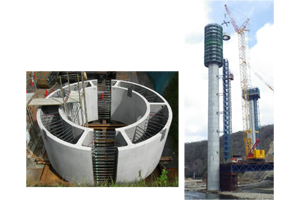
A method for rapidly constructing bridge piers using composite structures, in which the pier outer case is formed using precast panels with prearranged tie hoops embedded inside and the concrete is poured in. The construction period may be significantly shortened by reducing the manpower requirements for rebar assembly work, which accounts for a large part of the work process in pier construction. This method can be applied to both tall and short piers.
